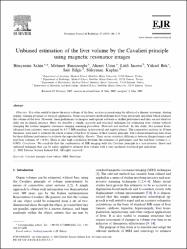| dc.contributor.author | Şahin, Bünyamin | |
| dc.contributor.author | Emirzeoğlu, Mehmet | |
| dc.contributor.author | Uzun, Aahmet | |
| dc.contributor.author | İncesu, Lütfi | |
| dc.contributor.author | Bek, Yüksel | |
| dc.contributor.author | Bilgiç, Sait | |
| dc.contributor.author | Kaplan, Süleyman | |
| dc.date.accessioned | 2020-06-21T15:56:13Z | |
| dc.date.available | 2020-06-21T15:56:13Z | |
| dc.date.issued | 2003 | |
| dc.identifier.issn | 0720-048X | |
| dc.identifier.issn | 1872-7727 | |
| dc.identifier.uri | https://doi.org/10.1016/S0720-048X(02)00152-3 | |
| dc.identifier.uri | https://hdl.handle.net/20.500.12712/22757 | |
| dc.description | Kaplan, Suleyman/0000-0003-1477-5002; Sahin, Bunyamin/0000-0001-8538-8443; | en_US |
| dc.description | WOS: 000184633100012 | en_US |
| dc.description | PubMed: 12880999 | en_US |
| dc.description.abstract | Objective: It is often useful to know the exact volume of the liver, such as in monitoring the effects of a disease, treatment, dieting regime, training program or surgical application. Some non-invasive methodologies have been previously described which estimate the volume of the liver. However, these preliminary techniques need special software or skilled performers and they are not ideal for daily use in clinical practice. Here, we describe a simple, accurate and practical technique for estimating liver volume without changing the routine magnetic resonance imaging scanning procedure. Materials and methods: In this study, five normal livers, obtained from cadavers, were scanned by 0.5 T MR machine, in horizontal and sagittal planes. The consecutive sections, in 10 mm thickness, were used to estimate the whole volume of the liver by means of the Cavalieri principle. The volume estimations were done by three different performers to evaluate the reproducibility. Results: There are no statistical differences between the performers and real liver volumes (P > 0.05). There is also high correlation between the estimates of performers and the real liver volume (r = 0.993). Conclusion: We conclude that the combination of MR imaging with the Cavalieri principle is a non-invasive, direct and unbiased technique that can be safely applied to estimate liver volume with a very moderate workload per individual. (C) 2002 Elsevier Science Ireland Ltd. All rights reserved. | en_US |
| dc.language.iso | eng | en_US |
| dc.publisher | Elsevier Ireland Ltd | en_US |
| dc.relation.isversionof | 10.1016/S0720-048X(02)00152-3 | en_US |
| dc.rights | info:eu-repo/semantics/closedAccess | en_US |
| dc.subject | Cavalieri principle | en_US |
| dc.subject | liver volume | en_US |
| dc.subject | MRI | en_US |
| dc.subject | stereology | en_US |
| dc.title | Unbiased estimation of the liver volume by the Cavalieri principle using magnetic resonance images | en_US |
| dc.type | article | en_US |
| dc.contributor.department | OMÜ, Tıp Fakültesi, Temel Tıp Bilimleri, Anatomi Ana Bilim Dalı | en_US |
| dc.identifier.volume | 47 | en_US |
| dc.identifier.issue | 2 | en_US |
| dc.identifier.startpage | 164 | en_US |
| dc.identifier.endpage | 170 | en_US |
| dc.relation.journal | European Journal of Radiology | en_US |
| dc.relation.publicationcategory | Makale - Uluslararası Hakemli Dergi - Kurum Öğretim Elemanı | en_US |
















